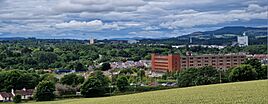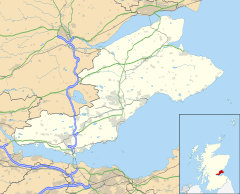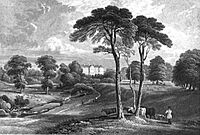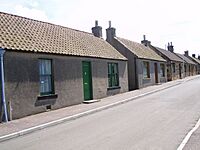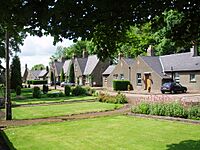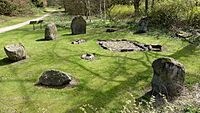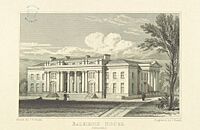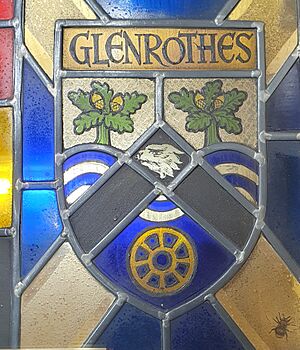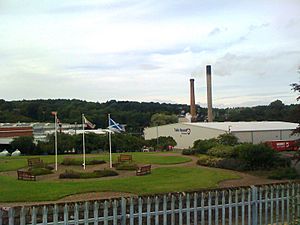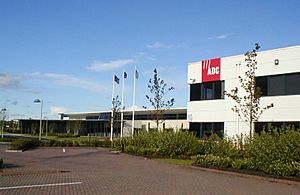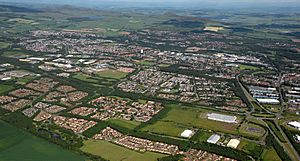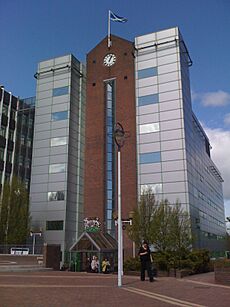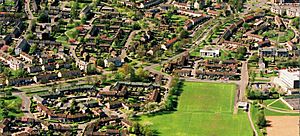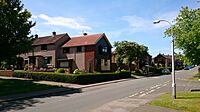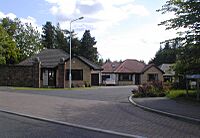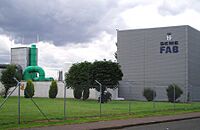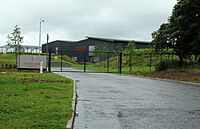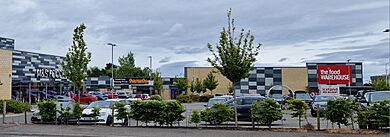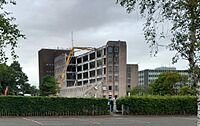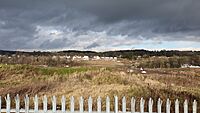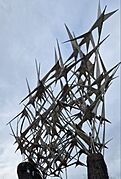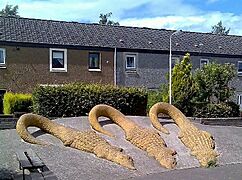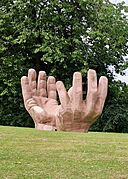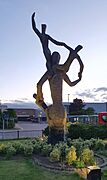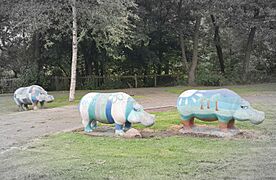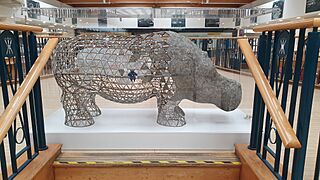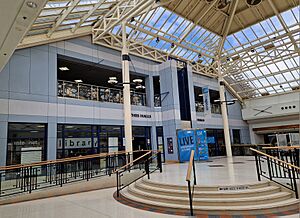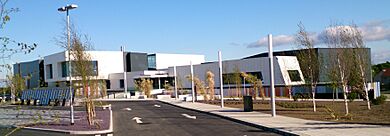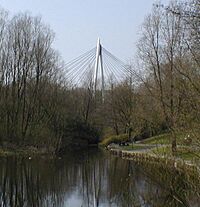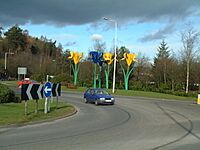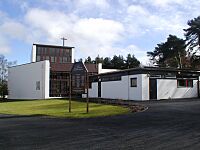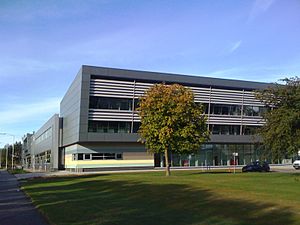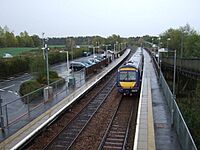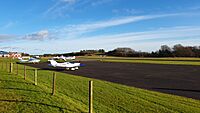Glenrothes facts for kids
Quick facts for kids Glenrothes
|
|
|---|---|
| Administrative centre and town | |
|
From top, left to right: View looking west towards Glenrothes from St Drostan's Cemetery, Markinch 'Giant Irises' sculpture Leslie Roundabout, The White Bridge crossing Riverside Park, 'Rothes Remembered' sculpture, 'The Hippo' sculpture in town centre, Aerial view of Riverside Park, |
|
| Area | 8 sq mi (21 km2) |
| Population | 38,360 (2020) |
| • Density | 4,795/sq mi (1,851/km2) |
| OS grid reference | NO281015 |
| • Edinburgh | 32 mi (51 km) |
| • London | 444 mi (715 km) |
| Council area | |
| Lieutenancy area | |
| Country | Scotland |
| Sovereign state | United Kingdom |
| Post town | GLENROTHES |
| Postcode district | KY6, KY7 |
| Dialling code | 01592 |
| Police | Fife |
| Fire | Fife |
| Ambulance | Scottish |
| EU Parliament | Scotland |
| UK Parliament |
|
| Scottish Parliament |
|
Glenrothes is a town in the middle of Fife, in east-central Scotland. In 2011, about 39,277 people lived there. This makes it the third largest town in Fife.
Glenrothes is the main administrative center for Fife. It is home to the headquarters of Fife Council and Police Scotland Fife Division. It is also a key service hub for the area.
The town was planned in the 1940s after World War II. It was Scotland's second "new town." Its goal was to help the economy grow in central Fife. This was meant to happen by building new homes, industries, and services. These were needed to support a new large coal mine called Rothes Colliery.
However, the mine closed early. So, the town's economy changed and grew in other ways. It became an important center for industry. It played a big part in creating Scotland's Silicon Glen from 1961 to 2000.
The name Glenrothes comes from its historical link to the Earl of Rothes. This family owned much of the land where the town was built. "Glen" (a Scottish word for valley) was added to the name. This was to avoid confusion with Rothes in Moray. It also shows that the town is in a river valley. The town's motto is Ex terra vis, which means "From the Earth Comes Life." This motto has been used since the town was founded.
Glenrothes has won many awards for its beautiful parks and gardens. It has many outdoor sculptures and artworks. These were created by town artists who worked there early on. The town is also a leader in high-tech electronics and manufacturing. Several companies have their main offices in Glenrothes. Big employers include Bosch Rexroth (making hydraulics), Fife College (education), Leviton (making fiber optics), and Raytheon (defense and electronics).
Glenrothes is special because much of its town centre is inside Fife's largest shopping mall, the Kingdom Shopping Centre. Public places include a sports and leisure center, two golf courses, large parks, a civic centre and theatre, and a college campus.
The A92 trunk road is the main road into Glenrothes. It connects the town to other major roads in Scotland. A large bus station in the town center offers bus services. Glenrothes is near the Edinburgh–Dundee line and Fife Circle rail line. Train stations serving the town are at Markinch and Thornton.
Contents
History of Glenrothes
How Glenrothes Got Its Name
The name for Glenrothes was chosen by the Fife Planning Committee on July 4, 1947. They looked at twelve names. Glenrothes and Westwood were the top choices. Joseph Westwood, a politician who supported the new town, was honored with the name Westwood. However, Glenrothes won the final vote. Sadly, Joseph Westwood died in a car accident just 18 days later.
The name "Rothes" comes from the Earl of Rothes and the Clan Leslie family. This family used to own a lot of the land where Glenrothes was built. They also gave their name to the nearby village of Leslie. The word "Glen" was added. It comes from the Scottish Gaelic word gleann, meaning valley. This was done to avoid confusion with Rothes in Moray. It also shows that the town is located in the River Leven valley.
Different parts of Glenrothes are named after old small villages like Cadham and Woodside. Some are named after farms that were there before, such as Caskieberran and Collydean. Others are named after historic homes like Balbirnie and Balgeddie.
Ancient Settlements in Glenrothes
Glenrothes has remains of ancient stone circles. You can see them at Balbirnie and Balfarg in the northeast of town. The Balfarg henge was built around 3000 BC. It has parts of a stone circle that have been rebuilt. The Balbirnie stone circle and cairn are very close to Balfarg. They were moved a short distance to a new spot to make way for the A92 road. Scientists believe the Balbirnie stone circle is from the Bronze Age. It is thought that both stone circles were once part of a larger ceremonial area.
There are also old country houses in Glenrothes. Balbirnie House, a beautiful Georgian building, was bought in 1969. It was turned into Balbirnie Country Park and a Golf Course. Later, it became a four-star hotel in 1989. Balgeddie House, built in the 1930s, is also now a hotel. Leslie House, a 17th-century home of the Earl of Rothes, was badly damaged by fire in 2009. Plans to restore it were approved in 2019. Much of its old land is now Riverside Park. Collydean has the ruins of a 17th-century house called Pitcairn House.
Before Glenrothes was built, the land was mostly used for farming. There were also small villages like Cadham and Woodside. These villages housed workers from local paper mills.
Building the New Town
Glenrothes was chosen as Scotland's second "new town" in 1948. This was part of the New Towns Act 1946. The Glenrothes Development Corporation (GDC) was in charge of planning and building the town. Their first meeting was in 1949.
The first idea was to build a town for 32,000 to 35,000 people. They thought about building it around Markinch. But Markinch was too small for such a big town. People in the area also didn't want it there. So, the new town was built on 5,320 acres of land between several villages. This land included parts of old estates and country houses like Balbirnie House.
Unlike other new towns in Scotland, Glenrothes was not originally meant for people moving from Glasgow. However, it did help house families from Scotland's declining coal mining areas in the 1950s. Glenrothes is also the only new town in Scotland not named after an existing village. It was a completely new settlement.
Glenrothes' Industries Over Time
Before Glenrothes was built, the main jobs in the area were papermaking, coal mining, and farming. Paper mills like Auchmuty and Rothes Mills used the River Leven for power.
After World War II, the Scottish government wanted to boost energy production. They invested a lot in the coal industry. Glenrothes was planned to support this. A report in 1946 suggested a new town in the Leslie-Markinch area to help the growing coal mining industry in Fife.
The Rothes Colliery, a new coal mine, was built near Thornton. Queen Elizabeth II opened it in 1957. It was supposed to bring many jobs to central Fife. But the mine had problems with flooding and geology. Also, people needed less coal. So, the mine closed in 1965.
In the 1960s, a company called Cadco Development Ltd promised to bring 2,000 jobs to Glenrothes. They planned to open factories and a supermarket. However, the company did not have enough money to follow through. This caused many problems and job losses. The town faced a difficult time.
After the mine closed and the Cadco problems, the government changed Glenrothes' role. It became a key area for economic growth in Central Scotland. The Glenrothes Development Corporation (GDC) worked hard to attract new, light industries and electronics factories. The first big electronics company was Beckmans Instruments in 1959. Then came Hughes Industries in the early 1960s. Many other important companies followed. This made Glenrothes a major industrial hub in Scotland's Silicon Glen. In the mid-1970s, Glenrothes also became the administrative center of Fife.
Large industrial areas were built south of Glenrothes. This was because they were close to the new A92 road. This road connected Glenrothes to Scotland's main road network. The electronics industry grew fast in the 1990s. Canon opened its first UK factory in Glenrothes in 1992. ADC Telecommunications, a big American electronics company, also opened a base in 2000.
Around the year 2000, the electronics industry in Scotland started to decline. This affected Glenrothes' economy. The town's industries had to change again. By 2004, both ADC and Canon had closed their operations in Glenrothes. This showed that the town's economy needed to be more diverse.
Glenrothes Today
The GDC finished its work in 1995. Fife Council then took over most responsibilities for Glenrothes. The GDC had built over 15,000 houses and many industrial and shopping areas. Since then, Glenrothes has continued to be Fife's main administrative center. It is also a major hub for services and jobs.
In 2009, Glenrothes was given the "Carbuncle Award" for its "depressed and investment starved town centre." This caused mixed feelings among locals. However, in 2010, the town won awards for being the "Best Kept Large Town" and the most "Clean, sustainable and beautiful community" in Scotland. It also won the "large town" category in the 2011 Royal Horticultural Society Britain in Bloom competition. The town won more Gold awards in 2013 and 2014.
In 2011, Historic Scotland recognized Glenrothes' public artworks. They gave "listed" status to several pieces. This showed that Glenrothes played a big part in using art to create a sense of place.
Glenrothes' importance in Scotland's history is shown in the Great Tapestry of Scotland. This tapestry was unveiled in 2013. The Glenrothes panel shows the town's public artworks and its industrial past. It highlights its history with coal mining and then the "Silicon Glen" industries.
In 2015, Tullis Russell Papermakers, a company that had been in the area for 200 years, closed down. The Scottish Government and Fife Council created a taskforce to help with job losses. They set aside about £6 million to support new projects. These included the Queensway Technology Park and the Glenrothes Enterprise Hub. New homes, shops, and businesses are now being built on the old paper mill site.
The Glenrothes Energy Network started in 2017. It uses heat from the RWE Markinch Biomass CHP plant. This project provides low-carbon heat to Council offices, businesses, and homes in Glenrothes. It was Scotland's first 100% renewable biomass heat and power network.
How Glenrothes is Governed
In the early days, the Glenrothes Development Corporation (GDC) managed the town. They worked with Fife County Council. Later, the GDC was closed down in 1995. Its responsibilities were given to private companies, local councils, or other government groups.
Glenrothes has different levels of government. The North Glenrothes Community Council and Pitteuchar, Stenton and Finglassie Community Council are the lowest level. They share local opinions with bigger governments.
Fife Council is in charge of local government in the region. Its main headquarters are in Fife House in Glenrothes town center. Glenrothes is divided into three of Fife Council's 22 electoral wards: Glenrothes Central and Thornton (ward), Glenrothes North, Leslie and Markinch (ward), and Glenrothes West and Kinglassie (ward).
For the United Kingdom Parliament, Glenrothes is part of the Glenrothes and Mid-Fife area. This area elects one MP to the House of Commons. Richard Baker of the Labour Party became the MP in 2024.
For the Scottish Parliament, Glenrothes is part of the Mid Fife and Glenrothes area. This area elects one Member of the Scottish Parliament (MSP). Jenny Gilruth MSP of the Scottish National Party represents this area.
Geography and Climate
Glenrothes is located in the middle of Fife, away from the coast. It is between the farming areas in the north and east, and Fife's industrial areas in the south and west. Its closest neighbors are Coaltown of Balgonie, Leslie, Markinch, and Thornton. These towns are so close that their boundaries almost touch.
Kirkcaldy, a larger town, is about 7 miles (11 km) south on the coast. Glenrothes is also about 19 miles (31 km) from Dunfermline and 21 miles (34 km) from St Andrews. Two of Scotland's big cities, Edinburgh and Dundee, are about 32 miles (51 km) and 27 miles (43 km) away. Perth is 23 miles (37 km) to the northwest.
The northern parts of Glenrothes are on the southern edge of the Lomond Hills Regional Park. The middle of the town is between the Warout Ridge and the River Leven valley. This valley is a large green space that runs through the town. The southern parts of Glenrothes are mostly industrial. They gently slope south towards the Lochty Burn and Thornton. The town center is about 300 feet (91 meters) above sea level.
Like most of Scotland, Glenrothes has a mild maritime climate. Summers are usually cool, with temperatures between 18°C and 25°C. Winters are mild, with temperatures between 0°C and 10°C. The temperature rarely drops below -5°C. This is because it is close to the ocean and the Gulf Stream.
Glenrothes has a network of natural green areas. These areas help different plants and animals to live there. There are old woodlands in Riverside Park and Balbirnie Park. Balbirnie Park is known for its large collection of rhododendron plants. Protected wildlife in the area includes red squirrels, water voles, and various types of bats. These green areas also help with drainage, reducing the risk of flooding. The town's many roundabouts also have green spaces, connecting different parts of the town.
Town Design and Buildings
The town was carefully planned. It has separate neighborhoods, each with its own look. Engineers, planners, and architects worked to build good quality homes. They also created green spaces, planted trees, and made wildlife corridors. This helped the new town feel like a real place where people would want to live. A key part of the plan was to keep industries separate from housing areas. This was different from older towns where homes and factories were often very close.
The goal for Glenrothes was to be a clean, healthy, and safe place. Much of the housing was council housing built by the Glenrothes Development Corporation. This helped them create a planned environment. It also provided affordable homes for workers in the new industries. These homes also helped people move from crowded areas in Scotland's industrial center.
Glenrothes was built using several masterplans. Building started in Woodside in the east and moved west. Early neighborhoods followed the Ebenezer Howard's Garden City idea. They had their own primary schools, local shops, and community centers.
A second masterplan was made in the late 1960s. It planned for a larger population of 50,000 to 70,000 people. New areas were chosen for building in the north and south. The road network was updated for more cars. New housing estates were built to the west, then south, and finally north.
The neighborhoods built in the 1960s and 1970s used Radburn principles. This meant keeping footpaths separate from roads. Houses were designed to face public paths and open spaces. Car parking was usually at the back of houses or in nearby parking areas.
From the 1980s onwards, private companies built most of the new homes. These were often in suburban cul-de-sacs. Trees and open spaces were planned to help homes and factories blend into the landscape.
Economy and Jobs
The economy of Glenrothes mainly includes manufacturing, engineering, service sector, health, and public sector jobs. In 2023, about 24,225 people worked in the Glenrothes area. This is about 18% of all jobs in Fife. Glenrothes is known for having many advanced manufacturing and engineering companies. It has 46 of the "Top 200 Fife Businesses." Major job areas include Bankhead, Eastfield, Pentland Park, and Queensway.
Local Industries
In 2011, manufacturing made up almost 15% of jobs in Glenrothes. Many high tech companies are in the town, especially in electronics manufacturing. These are what remain of the Silicon Glen operations. Local companies include Compugraphic, CTDI, Leviton, Raytheon, and Semefab. Other big companies are Bosch Rexroth (hydraulics) and Velux (windows).
In 2013, a new Scotch whisky distillery called Inchdairnie was started in Glenrothes. It opened in 2016, creating 15 new jobs. It focuses on exporting whisky to India, Africa, and the Far East. This distillery is working to use hydrogen to reduce its carbon footprint.
Velux, a roof window company, announced a £7 million expansion of its UK and Ireland headquarters in Glenrothes in 2018. The project included renovating their main office and building a new structure.
Scotch Whisky Investments (SWI) built a whisky storage facility in 2023. This created about 38 full-time jobs. SWI wants to make Glenrothes a center for whisky investment and storage.
Shopping, Fun, and Services
Retail jobs made up about 11% of all jobs in 2011. Most shops and services are in the town centre. The Kingdom Shopping Centre has about 120 shops. New shops and drive-thru units, including a M&S foodhall, opened between 2018 and 2021.
Fun and community places in the town center include the Rothes Halls. This is the main theater, exhibition, and civic center. It also has the town's main library and a cafe. There is a cinema, restaurants, a pub, and a bingo hall near the Kingdom Centre. You can also go Ten-pin bowling at Albany Gate.
Many big supermarkets like Asda and Morrisons are in the Queensway business park. There is also a retail park at the Saltire Centre, with stores like Matalan and Homebase.
Other service jobs include hotels and food services. Balbirnie House Hotel, Balgeddie House Hotel, and Premier Inn are the largest hotels. There are also budget hotels like the Golden Acorn Hotel and a Travelodge.
Financial and professional services make up 15.6% of jobs. Offices are mostly in the town center and at Pentland Park. An enterprise hub opened in 2017 to help new businesses.
Public Services and Community Groups
Many public service and community groups are based in Glenrothes. Police Scotland has its Fife Division headquarters here. The Scottish Environment Protection Agency (SEPA) and Scottish Enterprise also have offices. Fife College is a big employer with a large campus. Fife Council is also a major employer, with its headquarters in the town center.
Future Plans for Glenrothes
There are plans to improve the town center. These plans aim to bring new businesses and create new public spaces. Older parts of the Kingdom Shopping Centre might be torn down and rebuilt. The former police station site is also planned for new uses. Fife Council announced in 2023 that Rothesay House would be demolished as part of these plans.
Glenrothes will be home to the UK's first 100% Green Data Centre. This £40 million project will create over 300 construction jobs and up to 50 full-time jobs. It will get its energy directly from the RWE biomass plant in the town.
There are also plans to improve the western neighborhoods, especially around the Glenwood Centre. The Glenwood Centre was demolished in 2023 to make way for new homes, shops, and a community hub.
Many new housing developments are happening. Over a thousand new homes will be built between 2022 and 2030.
In 2023, the UK Government announced £19.4 million in funding for Glenrothes. This money will go to the River Leven Regeneration project. It will also help improve the town centers of Glenrothes and Leven. Improvements in Glenrothes Riverside Park include new electric vehicle charging, public toilets, and an upgraded children's play park with a giant hippo sculpture. There will also be a state-of-the-art pump track for bikes and scooters. The goal is to make the park a "must-visit" place for both tourists and locals.
Culture and Community
Public Artworks in Glenrothes
In 1968, Glenrothes was the first town in the UK to hire a town artist. This helped create the idea that art can make a place feel special. Two town artists, David Harding (1968–78) and Malcolm Robertson (1978–91), created about 140 artworks and sculptures around the town. Malcolm Robertson made the "Giant Irises" sculpture for the Glasgow Garden Festival. It later moved to Leslie Roundabout.
Other artists also added to the town's art. The first sculpture was "Ex Terra" by Benno Schotz. Its name comes from the town's motto, Ex Terra Vis, meaning "From the earth strength." "The Good Samaritan" sculpture in Riverside Park was made by Ronald Rae for the town's 40th anniversary. The concrete hippos around town were designed by Stanley Bonnar.
-
"Ex Terra" sculpture by Benno Schotz
Four artworks in Glenrothes have been given listed status by Historic Environment Scotland. These include "Ex Terra," "The Birds," "The Henge," and "Work."
For the town's 75th anniversary in 2023, a new artwork called "The Disappearing Hippo" was unveiled. It was made by Stanley Bonnar using recycled materials.
Town Facilities and History Spots
Rothes Halls is the town's main theater, exhibition, and civic center. It also has the town's main library and a cafe. It opened in 1993 and hosts many local and international shows. Some exhibits from the old Glenrothes & Area Heritage Centre are now in the Rothes Halls.
A war memorial was built in Glenrothes in 2007. Before this, the town could not hold its own Remembrance Sunday events. This memorial is unique, made of two linking rings of standing stones.
Glenrothes Hospital
Glenrothes Hospital is a community hospital in the northwest of the town center. It opened in 1981. The hospital has over 80 nursing staff and more than 60 beds. It offers many services like speech and language therapy, occupational therapy, and physiotherapy. However, it does not have an accident and emergency service.
Clubs, Groups, and Events
Glenrothes has many social clubs and groups. These include an art club, youth clubs, theater groups, and sports clubs. The town hosts an annual gala at Warout Park. It has family activities like a dog show, highland dancing, and a travelling funfair. Summer and winter festivals were held in Riverside Park in 2012. The winter festival included the town's annual fireworks display.
Parks and Gardens
The town has won many awards for its beautiful landscaping. About one-third of Glenrothes' land is open space. The largest parks are Balbirnie Park, Carleton Park, Gilvenbank Park, Riverside Park, and Warout Park. The Lomond Hills Regional Park is also nearby.
Sports and Leisure
Glenrothes has many sports and leisure facilities. These include two 18-hole golf courses (Glenrothes and Balbirnie), outdoor skateparks, and an indoor ten-pin bowling alley. There is also a football stadium at Warout Park and private gyms. The Michael Woods Sports and Leisure Centre is a major sports complex. It was recognized for its design in 2014. In 2018, a new indoor training facility with a 3G football pitch opened next to it.
The town's football club is Glenrothes F.C.. They play at Warout Stadium. The local rugby club is Glenrothes RFC. There is also a local cricket club. The Road Running Festival is the biggest annual sports event, with over 1500 people taking part since 1983. Glenrothes also hosts the BDO British International Championships for darts.
Town Twinning
Glenrothes has a twin-town link with Böblingen, a city in Germany. This link started in 1971. Teachers from Glenrothes High School and a school in Böblingen helped start the friendship. Since then, there have been many exchanges between people and groups from both towns.
Famous People from Glenrothes
- The actor Dougray Scott grew up in Glenrothes.
- Henry McLeish, who used to be the First Minister of Scotland, lived in Glenrothes.
- Tricia Marwick, the first female Presiding Officer of the Scottish Parliament, was an MSP for Glenrothes.
- John Wallace, a famous trumpeter, grew up nearby and played in the Tullis Russell Mills Band. He later became the head of the Royal Conservatoire of Scotland.
- Professional football players like Kevin McHattie, Billy MacKay, and David Speedie have lived in the town.
- Sergeant was an indie rock band formed in Glenrothes.
Landmarks in Glenrothes
The River Leven Bridge, also called the 'White Bridge', crosses Riverside Park. It was finished in 1995. This cable-stayed bridge was designed to be a landmark and a gateway to Riverside Park. It was the first reinforced-concrete cable-stayed bridge built in the UK.
Many of Glenrothes' artworks and sculptures are landmarks at the town's entrances. Examples include the "Giant Irises" at Leslie Roundabout and the "Gateway Totum" at Bankhead Roundabout.
The town also has several churches that are important landmarks because of their unique designs and locations. The three oldest churches are now listed buildings. These are St. Margaret's Church in Woodside, St. Paul's RC Church in Auchmuty, and St. Columba's Church in the town center. St. Paul's RC Church was designed by famous architects Gillespie, Kidd and Coia. St Columba's Church has a large mural inside by Alberto Morrocco. Its unique triangular bell tower and colorful stained glass windows make it a landmark.
Balgonie Castle is east of Glenrothes. Its keep dates back to the 14th century and has been restored. It is a local landmark on the eastern side of Glenrothes.
Education in Glenrothes
Primary Schools
Early neighborhoods in Glenrothes each had their own primary schools. The first primary school, Carleton Primary School, opened in Woodside in 1953. In total, thirteen primary schools were built. One served Catholic pupils, and twelve were non-religious. In 2014, Fife Council decided to close Tanshall Primary School to save costs. Despite local opposition, the school closed and was demolished in 2016.
List of Primary Schools
- Carleton Primary School
- Caskieberran Primary School
- Collydean Primary School
- Newcastle Primary School
- Pitteuchar East Primary School
- Pitteuchar West Primary School
- Pitcoudie Primary School
- Rimbleton Primary School
- South Parks Primary School
- Southwood Primary School
- St Paul's RC Primary School
- Warout Primary School
Secondary Schools
Three secondary schools were built in Glenrothes. Auchmuty High School opened in 1957 for the eastern part of town. Glenwood High School was built in 1962 for the western areas. Before 1966, older students had to go to schools in other towns for higher exams. Glenrothes High School was built in 1966 for higher-level students. Later, Auchmuty and Glenwood were expanded to become full high schools.
Auchmuty High School serves the east and south of Glenrothes, and nearby villages. A new Auchmuty High School opened in 2013. Glenrothes High School serves the central and northern areas. Glenwood High School serves the western parts of Glenrothes and the villages of Leslie and Kinglassie. Catholic students in Glenrothes attend St Andrew's High School in Kirkcaldy.
College Education
College education in Glenrothes is provided at Fife College. The Glenrothes campus was built in the early 1970s. It first focused on paper manufacturing, mechanical engineering, and electrical engineering. A second center, FIPRE, was built next to it for sports and physical education. The college campus was greatly expanded in 2010 with the "Future Skills Centre." This center has departments for engineering, construction, and renewable energy.
Getting Around Glenrothes
Glenrothes has a well-planned road network. Main roads bypass the housing areas, connecting them to the town center and industrial estates. The town uses many roundabouts instead of traffic lights to keep traffic flowing smoothly.
The A92 Trunk Road passes through Glenrothes. It connects the town to Dundee in the north and Dunfermline in the southwest. This road links Glenrothes to Edinburgh and other major roads in central Scotland.
The A911 road goes east-west through the town. It connects Glenrothes to Levenmouth in the east and Milnathort in the west. The B921 Kinglassie Road links Glenrothes to nearby villages.
The town has a large bus station in the town center. It offers frequent bus services to Dundee, Edinburgh, Glasgow, Perth, and surrounding towns.
Glenrothes is near the Edinburgh–Dundee line and the Fife Circle rail line. Two train stations, Glenrothes with Thornton railway station and Markinch railway station, serve the area. Old branch lines that used to run through the town were closed in the 1960s and 1990s. Many of these old lines are now walking and cycling paths.
Glenrothes has a small airfield, Fife Airport. It is used for private light aircraft. Edinburgh Airport is the closest international airport.
The town has a planned system of pedestrian and cycle paths. This includes a nearly three-mile long path called Boblingen Way. It runs across Glenrothes, from Leslie in the west to Woodside in the east.
Glenrothes is also connected to the National Cycle Network via Route 766. The Fife Pilgrim Way, a long-distance walking route, passes through Glenrothes.
See also
 In Spanish: Glenrothes para niños
In Spanish: Glenrothes para niños


